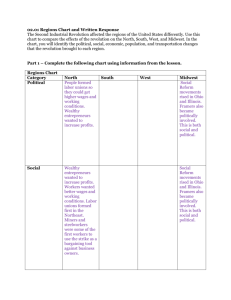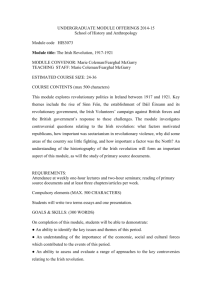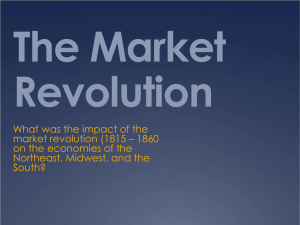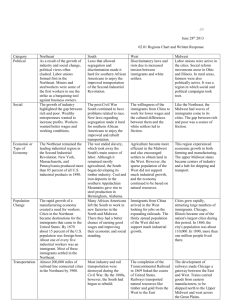America`s History Chapter 9
advertisement
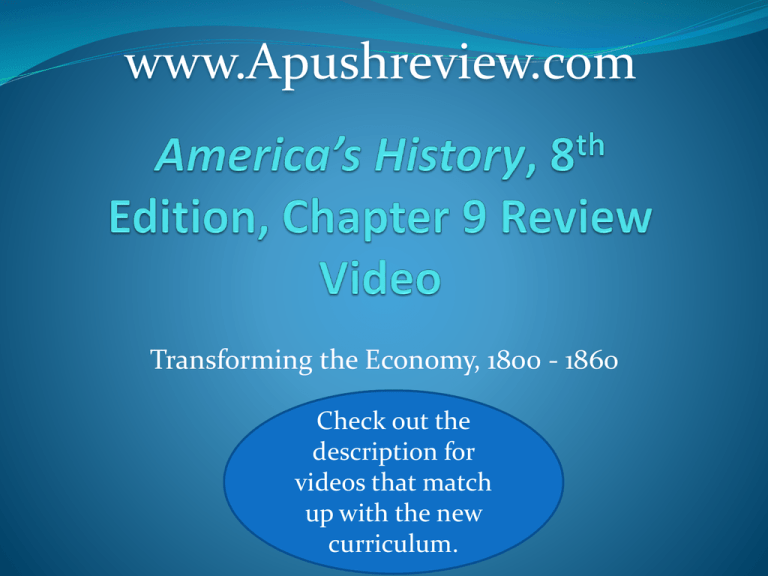
www.Apushreview.com Transforming the Economy, 1800 - 1860 Check out the description for videos that match up with the new curriculum. The American Industrial Revolution The Division of Labor and the Factory: Whether at home, or a factory, work became more rote and efficient by doing specific tasks (assembly line) Seen in slaughterhouses – PORKOPOLIS! – and shoe factories The Textile Industry and British Competition: The British government forbid mechanics and machines to leave Britain Samuel Slater – emigrated to America in disguise American and British Advantages: US had a tremendous amount of natural resources US instituted tariffs on foreign goods Britain had a large population (cheap labor) Better Machines, Cheaper Workers US improved on British machines Lowell System – farmers’ daughters that worked in factories Lived in housing provided by employers – curfews, no alcohol Many saw greater independence The American Industrial Revolution American Mechanics and Technological Innovation: US patents increased drastically between 1820 and 1860 Eli Whitney: Cotton gin (1793) – separated cotton from its seeds Interchangeable parts – used for guns, applied to other areas Products became more abundant and cheaper Wageworkers and the Labor Movement: Free Workers Form Unions: Unions formed to bargain with employers Early American law viewed unions as illegal Labor Ideology: Commonwealth v. Hunt (1837) Massachusetts State Supreme Court decision that declared unions legal More symbolic at the time ***The Market Revolution*** What is it? Change in labor systems, population, and transportation Greatly affected the Northeast and Midwest The Transportation Revolution Forges Regional Ties: Germans and Irish made up large portion of immigrants National Road (Cumberland, MD – Vandalia, Il) was funded by the federal government Canals and Steamboats Shrink Distance: Erie Canal – Albany to Buffalo – and beyond via Great Lakes and rivers Canals and roads changed the environmental landscape of US Other canals emerged connecting more of America together State governments subsidized canals Railroads Link the North and Midwest: Livestock and wheat were transported between the two regions Inventions that helped farmers – McCormick Reaper and Deere’s steel plow The South did not invest in manufacturing, relied on agriculture (cotton) The Growth of Cities and Towns: The Market Revolution increased the number of cities and towns Cities emerged as trading and manufacturing centers: Cincinnati, Buffalo, Pittsburgh, Chicago, etc. New Social Classes and Cultures Impacts of the Market and Industrial Revolutions? Larger houses, better clothes, cheaper products, distinct social classes The Business Elite: Prior to the Revolutions, social classes regularly interacted and dressed similar After, the wealthy dressed in finer clothing, had carriages and servants Employers and employees worked alongside each other less The Middle Class: Farmers, merchants, lawyers, etc. made up this emerging group 30% of the population in the 1840s in the northeast Wives bought books, pianos, etc. Middle-class children received a high school education Republican Motherhood New Social Classes and Cultures Urban Workers and the Poor: Poor workers were especially hit hard during economic downturns Children would often work to help provide for families The Benevolent Empire: Religious movement to reduce alcohol and vices Encouraged governments to ban carnivals Improved society by creating homes for orphans and asylums for those with mental illnesses Women played a large role in this movement Many laborers resisted this movement, especially laws restricting activities on Sundays New Social Classes and Cultures Charles Grandison Finney: Revivalism and Reform: Played an instrumental role in the 2nd G.A. Evangelical Beliefs: Preached individuals had free will – anyone could be saved Resonated with wealthy individuals in WNY Poor and immigrants were not as affected Temperance: American Temperance Society – 200,000 members People promised to abstain from alcohol Very influential Immigration and Cultural Conflict: “Old Immigration” – Germans and Irish Irish Poverty: Irish Potato Famine – settled in cities in Northeast, Catholics, tended to vote Democrat Nativism: Dislike/distrust of immigrants Many Protestants feared the power of the Pope Quick Review Lowell Girls Eli Whitney Impact of canals – Erie Impacts of the Market Revolution Connected NE and Midwest 2nd Great Awakening Charles Grandison Finney Temperance Nativism Thanks for watching! Good luck on your tests Check out videos matching the new curriculum Spread the word Subscribe Comment


